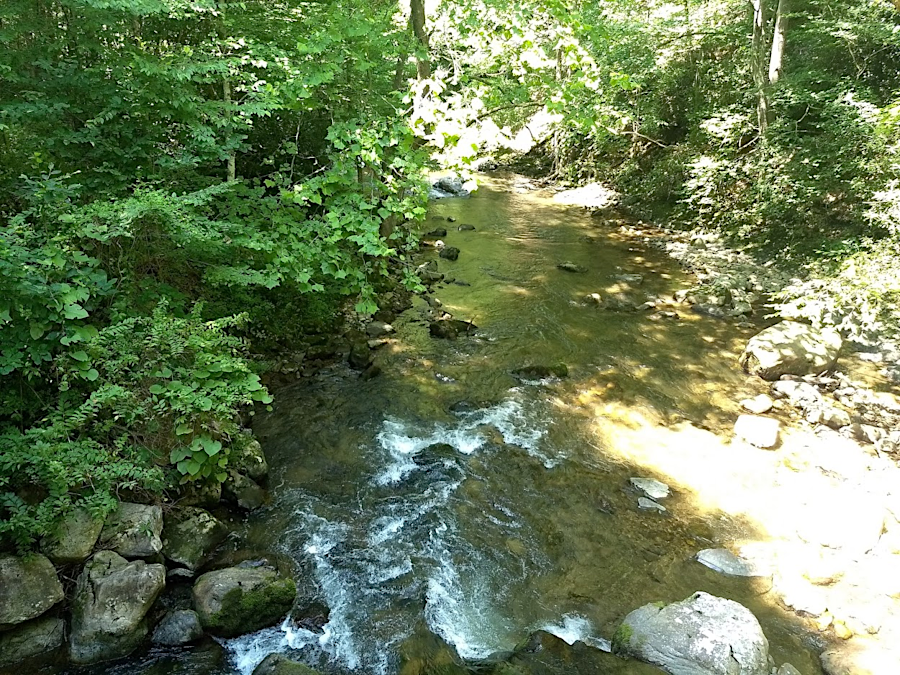
brook, brown, and rainbow trout are stocked in Whitetop Laurel Creek parallel to the Virginia Creeper trail (Washington County)

brook, brown, and rainbow trout are stocked in Whitetop Laurel Creek parallel to the Virginia Creeper trail (Washington County)
Trout are cold water fish, a relic of the last ice age. They are present today in the mountain streams and in some of the valleys west of the Blue Ridge. Water in the tidal rivers on the Coastal Plain is too warm, even in the portions near the Fall Line where the water is fresh.
Of the three species of trout in Virginia, only brook trout (Salvelinus fontinalis) are native. Rainbow trout (Oncorhynchus mykiss) evolved on the western slopes of the Rocky Mountains. No rainbow trout swam to Virginia on its own initiative; fishery managers hauled them and introduced them into Virginia waters.
Today most rainbow trout in Virginia are raised in state fish hatcheries, hauled to Virginia streams, and dumped ("stocked") into the water. That creates a seasonal put-and-take fishery for anglers to have fun. Rainbow trout do naturally spawn in a few streams, primarily around Mount Rogers.
Brown trout (Salmo trutta) also have been introduced and also spawn in Virginia as a naturalized species. There are 400 streams that provide 2,000 miles of cold water habitat for trout.1
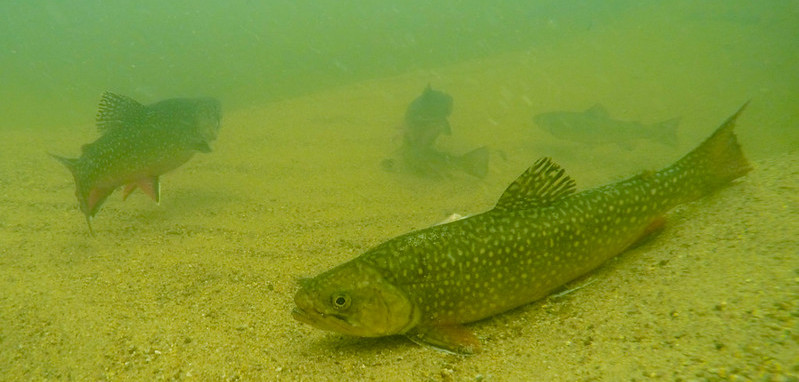
brook trout stocked in Piney Run near Purcellville
Source: Flickr, Brook trout stocked in Loudoun County, Virginia (Chesapeake Bay Program)
Brook trout were native to some Northern Virgina streams, at the edge of the Coastal Plain, until urban development altered the natural conditions. Increased runoff from impervious surfaces deposited sediments, reducing the potential for natural spawning. Runoff became warmer after raindrops landed on asphalt and concrete that was significantly hotter than the soil in natural forests. Trees that once shaded streams have been replaced by sidewalks and turf grass, allowing sunlight to heat the streams directly to temperatures beyond what trout can withstand.
As the climate changes and water temperature rises, the stream habitat of over 70 streams in Shenandoah National Park has becoming less suitable for brook trout. Between 1996–2022, the number of trout has declined by 50% in a majority of streams and disappeared completely from three streams.
While hunting is prohibited within the national park, fishing is authorized. As noted by the Federal agency:2
The future for the survival of brook trout in Shenandoah National Park is questionable. As streams get warmer, the fish lose the ability to survive at lower altitudes. Park officials have reported:3
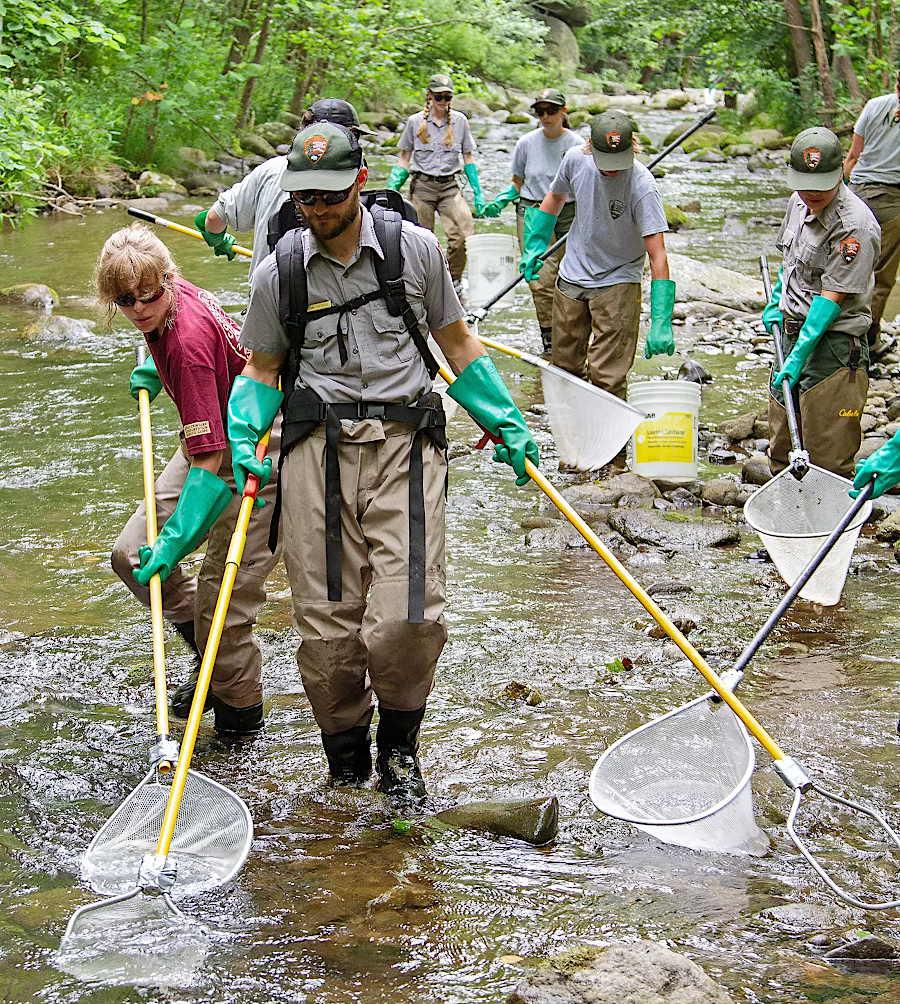
stream sampling for brook trout in Shenandoah National Park has revealed a decline in their populations due to climate change
Source: Shenandoah National Park, Researchers See Startling Brook Trout Declines in Shenandoah Streams
So anglers can plan ahead for a traditional "opening day," Trout Heritage Day is held on the first Saturday of April each year. The Department of Wildlife Resources announces where fish will be stocked, and encourages anglers to participate in the Virginia Trout Slam Challenge! Everyone who catches a brook, rainbow, and brown trout on that day is given a special sticker to display.4
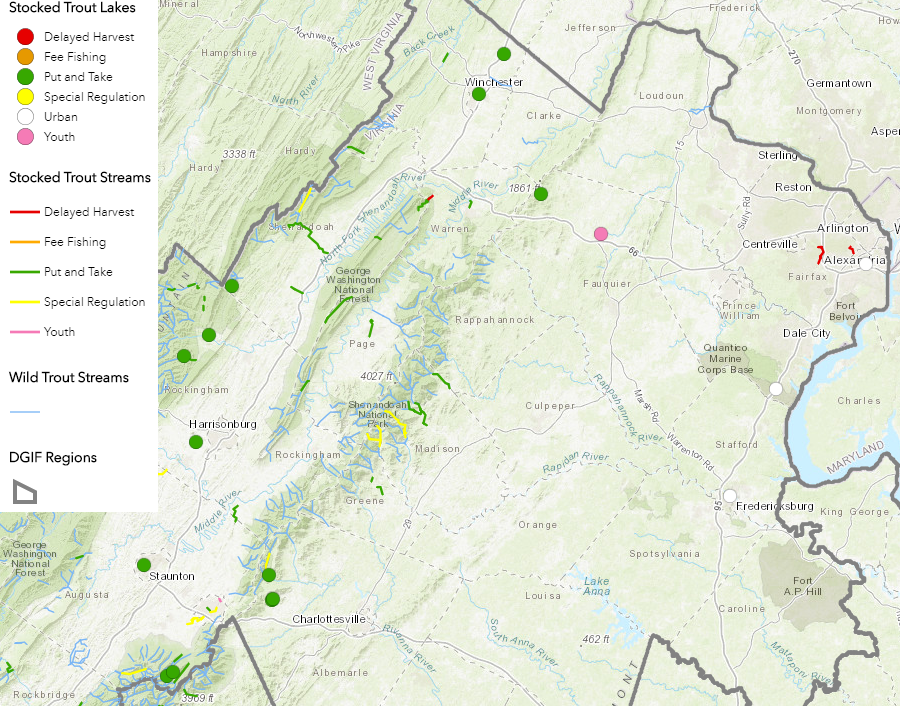
Virginia Department of Wildlife Resources stocks trout in selected streams and ponds
Source: Virginia Department of Wildlife Resources, Virginia Trout Fishing
Trout have been stocked in Four Mile Run for a short put-and-take fishing season in the early Spring. The trout last only about six weeks. Any not caught by then will struggle to survive in the warming water, which holds less oxygen than the fish require. A year-round trout population can not be re-established in Four Mile Run because:5

Four Mile Run flows through Arlington County from I-66 to Ronald Reagan Washington National Airport
Source: ESRI, ArcGIS Online
The Virginia Department of Wildlife Resources identifies where it stocks trout each year. Several sites are in urbanized Northern Virginia. They include Accotink Creek and Holmes Run, Cooke Lake in Alexandria, Locust Shade Park in Prince William County, and Old Cossey Pond in Fredericksburg.
In Bristol, fingerling rainbow and brown trout have been stocked in Beaver Creek since 2017. The stream is managed for a catch-and-release fishery, with public access available at Sugar Hollow Park. There are consumption advisories due to water quality issues, but water is cold in the spring-fed stream and the habitat supports trout.6
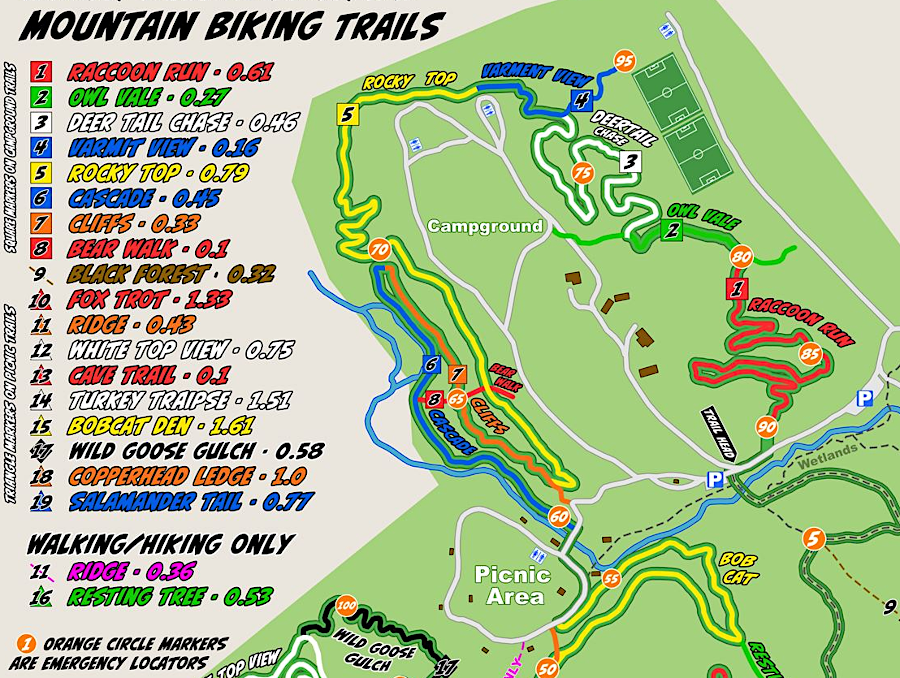
trout fishing in Bristol is available in Sugar Hollow Park, together with mountain biking trails and urban recreational facilities such as soccer and softball fields
Source: City of Bristol, Our NEW TRAIL MAP is here!
In all Designated Stocked Trout Waters, anglers need a trout license in addition to their base fishing license. The Virginia Trout Slam Challenge can be met by catching a brook, rainbow, and brown trout in the same day. Choosing where to fish is key to accomplishing it, and:7
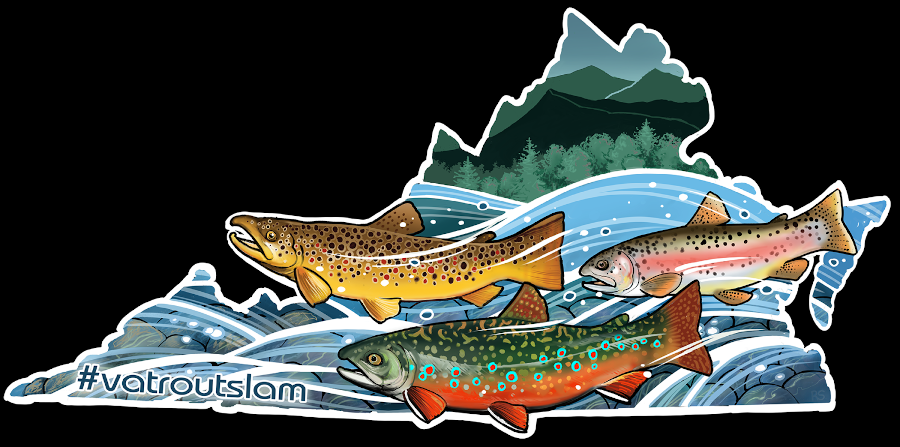
Virginia has brook, rainbow, and brown trout swimming wild in streams, plus stocked fish of all three species
Source: Virginia Department of Game and Inland Fisheries, Virginia Trout Slam Challenge
Anglers who fail to catch a trout may claim that the Department of Wildlife Resources feeds the fish before releasing them; supposedly the trout are not hungry, so they are less willing to bite and get caught. State hatcheries do feed fish daily, but feeding is stopped 24 hours before transport. No food is provided on the last day at the hatchery. Empty bellies reduces the potential of the trout to get "car sick" during transport.8
The Virginia Department of Wildlife Resources has introduced a new option, tiger trout. Tiger trout are a sterile hybrid, the result of breeding female brown trout and male brook trout. The eggs for tiger trout are hatched at the Paint Bank Fish Hatchery, then shipped to the Coursey Springs Fish Hatchery in Bath County to raise to catchable size. Stocking in Designated Stocked Trout Waters begins in late Winter/early Spring of 2022.
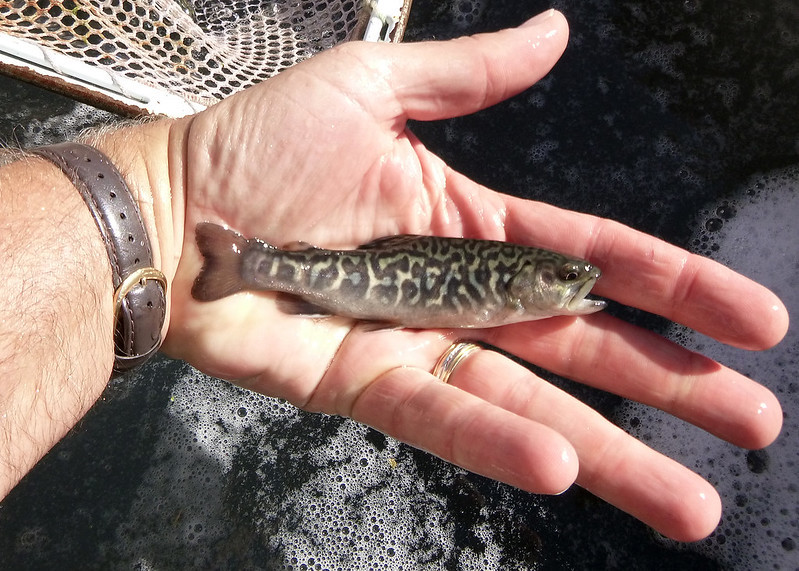
tiger trout have a distinctive striping pattern
Source: Oregon Department of Fish & Wildlife, 101215_tiger_trout_to_be_stocked_odfw
Tiger trout had been raised previously by the state agency, but low survival rate caused the program to be discontinued. Tiger trout production was renewed starting in 2020 because:9
A 1930's fish cultural station, originally developed by the Federal government, has become a private trout hatchery producing fish for restaurants. The new owners were a young couple with no background in aquaculture. They relied upon a 1930's book, and learned from experience:10
The Smoke In Chimneys hatchery relies upon cold mountain spring water flowing by gravity through the rearing ponds. A chef commented:11
In 2023, half the trout at the Smoke In Chimneys hatchery died when a pipe shifted and water levels dropped. The hatchery relied upon natural water flow through the ponds and raceways; there were no pumps or aerators. When the pipe was dislocated, low water flow produced low oxygen levels. When dissolved oxygen in the water dropped below the threshold required by trout, they started to die.
Friends and neighbors responded to a call for help from the hatchery owners who faced economic disaster. Volunteers processed and froze fish, held fundraisers, and demonstrated community support.12
In Winchester, Trout Unlimited initiated a Trout in the Classroom program in 2005. Elementary, middle school, and high school students raise trout in the Spring, then release them into Wilkins Lake in Jim Barnett Park. The hands-on program is integrated with the curriculum for chemistry, biology, and even history. As described by one teacher:13
Source: Mountain Roots, Abandoned 1930s Trout Hatchery Reborn In Hills of Appalachia!
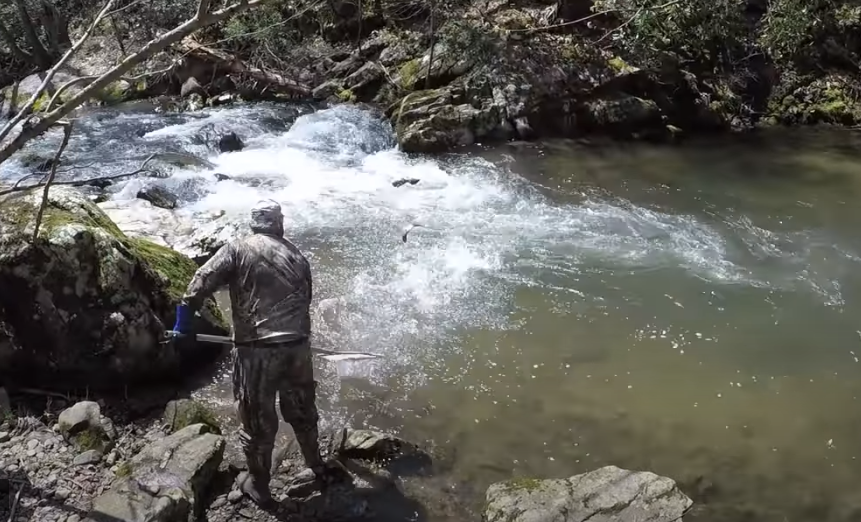
mature trout are tossed into the middle of streams, jolting them to start swimming
Source: Virginia Department of Wildlife Resources, Top 5 Virginia Trout Stocking Myths

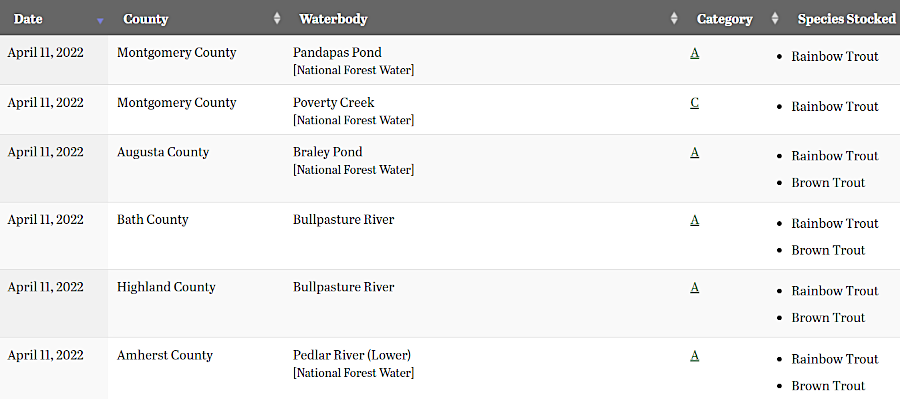
the schedule for stocking trout for the put-and-take fishery is advertised by the Virginia Department of Wildlife Resources
Source: Virginia Department of Wildlife Resources, Daily Trout Stocking Schedule
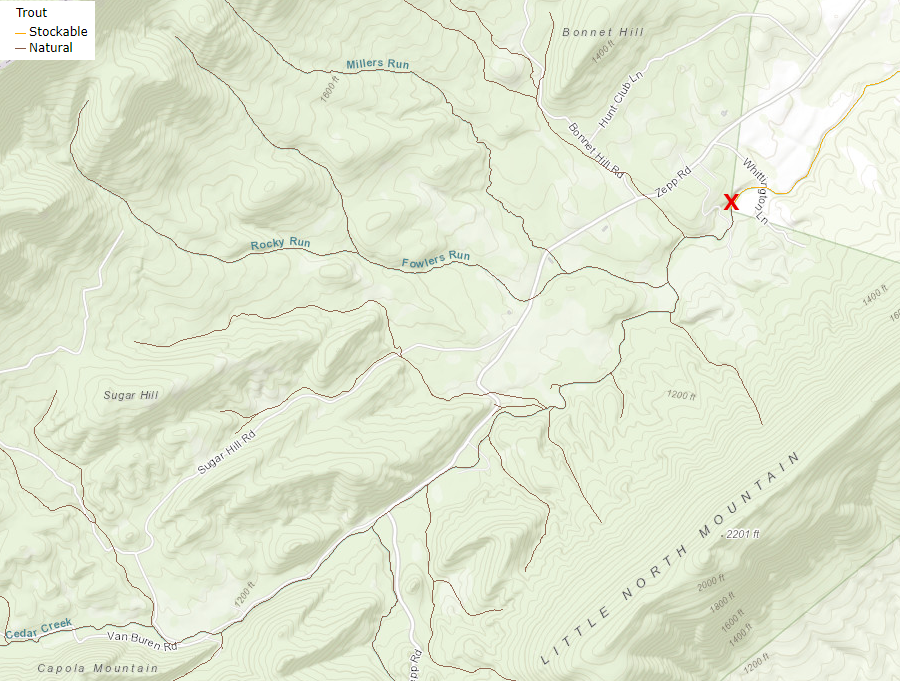
trout could be stocked in waters downstream (below red X) of remaining suitable natural habitat
Source: Virginia Department of Environmental Quality (DEQ), VEGIS
Source: Virginia Department of Wildlife Resources, Bringing Trout to the Cities - Virginia's Urban Trout Stocking Program
Source: Virginia Department of Wildlife Resources, Raising Trout in Virginia - Episode 1
Source: Virginia Department of Wildlife Resources, Raising Trout in Virginia - Episode 2
Source: Virginia Department of Wildlife Resources, Raising Trout in Virginia - Episode 3